On the Way to the Trevi Fountain
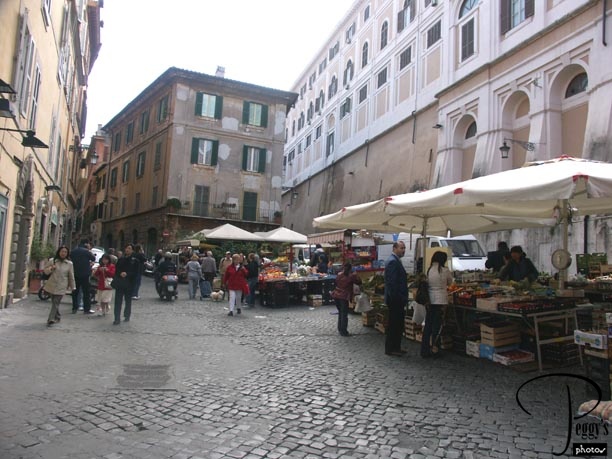
The Green Line picked me up again to go on their Classical Rome Tour––Trevi Fountain, Pantheon, Piazza Navona, and St. Peter’s Basilica. You should recognize by now this street scene in the photo––I was here twice before. Why do I keep ending up at the Trevi Fountain? This is because the tour buses can stop long enough to let off their passengers only in a few spots in Rome. The streets to the Pantheon are the same as to the Trevi Fountain and to get to the Pantheon we needed to pass the Trevi Fountain.

On the Way to the Trevi Fountain
Trevi Fountain
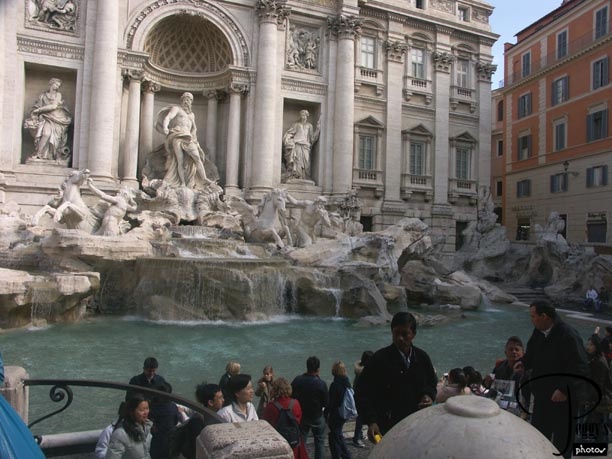
The Trevi Fountain, again.

Trevi Fountain
Neptune
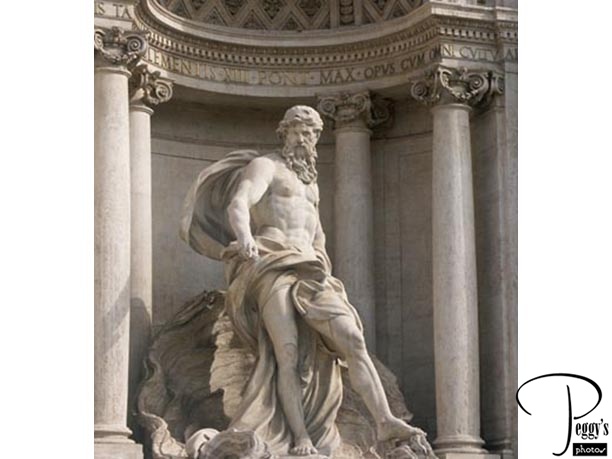
A close–up of Neptune at the Trevi Fountain. I kept finding more photos to take at the Trevi Fountain each time I went back there.

Neptune
Neptune
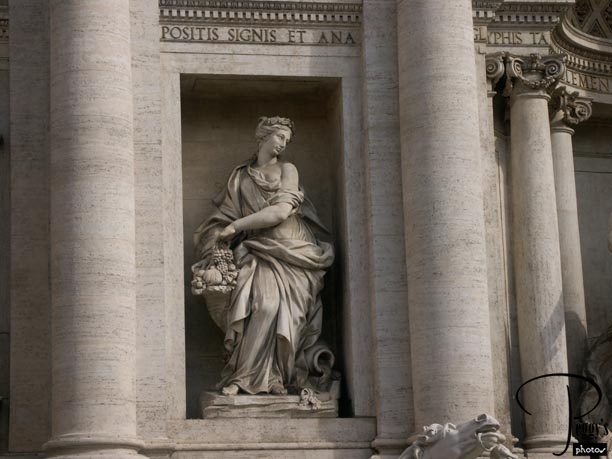
The statue on to the left of Neptune.

Neptune
Neptune
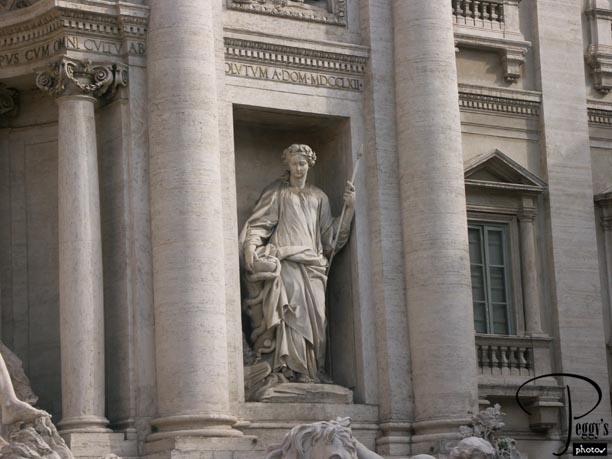
The statue to the right of Neptune.

Neptune
Trevi Fountain
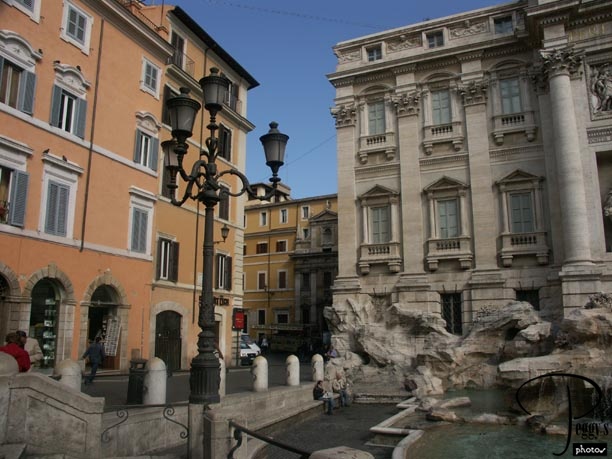
Plenty of sitting room here this morning.

Trevi Fountain
Wall Decoration
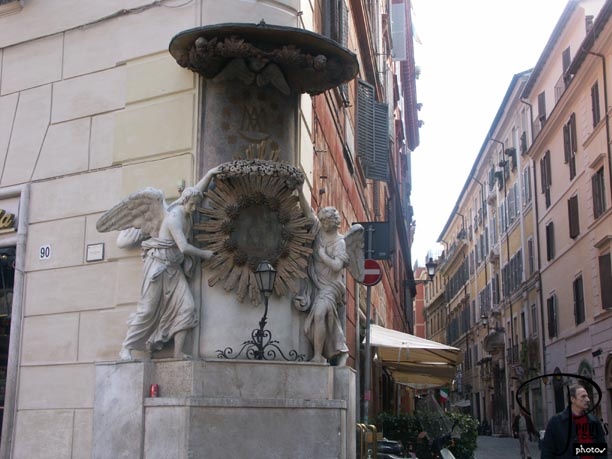
Interesting wall decoration at this square. This is the first time that I noticed it. I didn’t see the chestnut seller here this morning.

Wall Decoration
Souvenir Stand
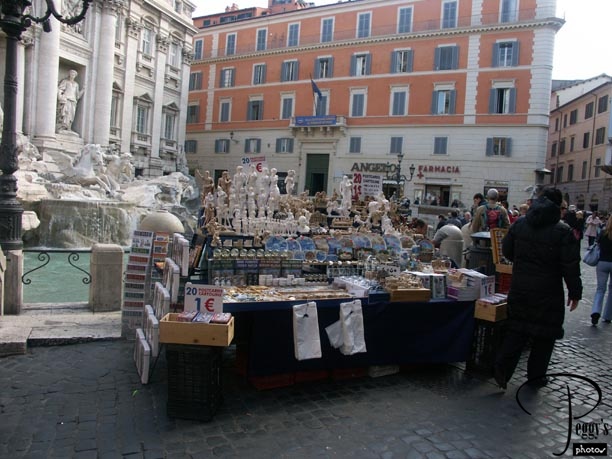
Souvenir stand at the Trevi Fountain.

Souvenir Stand
Palazzo di Montecitorio & Obelisk of Montecitorio
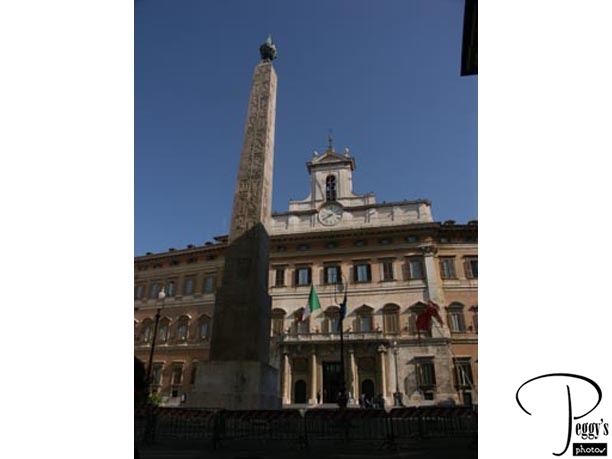
The Italian Chamber of Deputies (Parliament) meet in the Palazzo di Montecitorio. Rome is the center of the Italian government and it is odd to find that their government buildings are located in tourist areas and have little security around them. The Obelisk of Montecitorio dates back to ancient times.

Palazzo di Montecitorio & Obelisk of Montecitorio
Pantheon
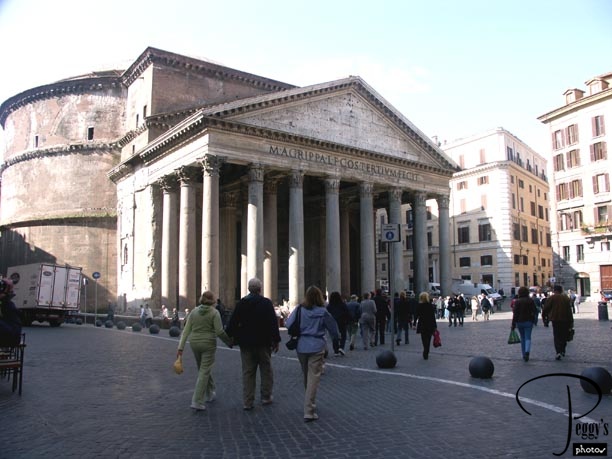
Yesterday, I couldn’t remember whether this tour was to take me to the Pantheon, but here I am. The Pantheon is Rome’s best–preserved monument. It was built by the Emperor Hadian about 120 A.D.

Pantheon
Doors of the Pantheon
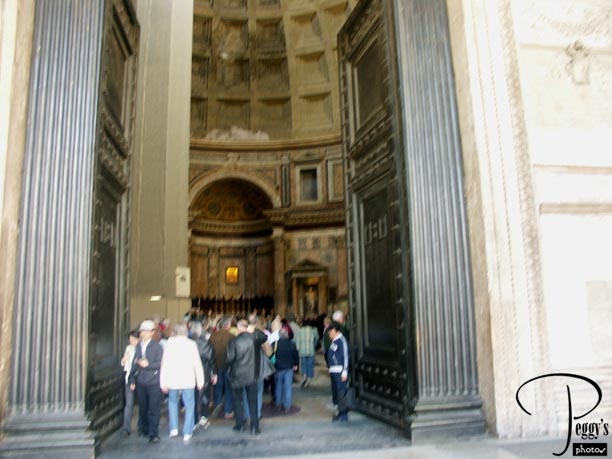
Note how massive and tall these doors are.

Doors of the Pantheon
Inside the Pantheon
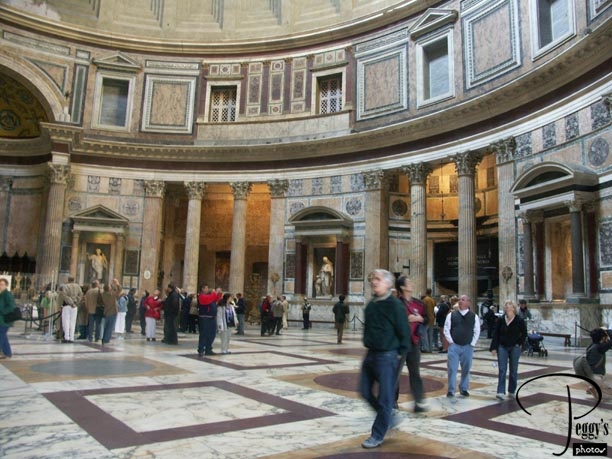
The floor and wall panels are mostly the original ones.

Inside the Pantheon
The Dome
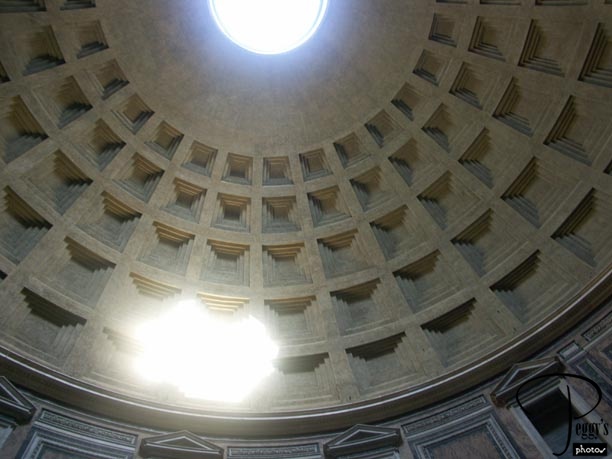
The center of the dome of the Pantheon is open. Rain is allowed to enter the building. There are small holes in the floor to allow the water to seep out and it does this into the Tiber River. The open dome also works as a sundial. The Romans could tell the time of the day by where the sun was shining on the floor. This dome was the model for the dome at St. Peter’s Basilica.

The Dome
Tombs
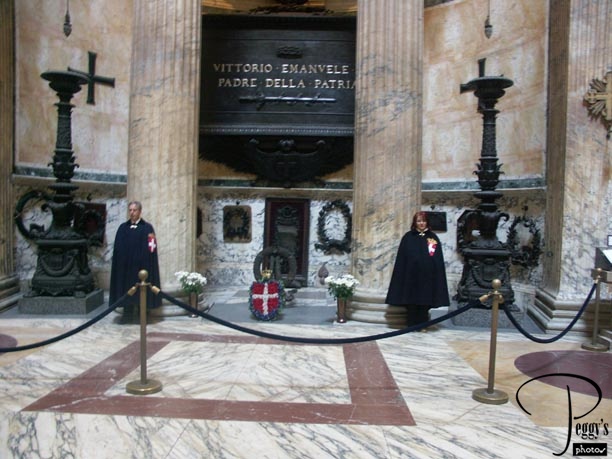
The first two kings of modern Italy are buried here: King Victor Emmanuel II and King Umberto I. This photo is of the tomb of Victor Emmanuel II. These are volunteers on either side of the tomb are guarding it. Raphael is also buried here but there was a curtain around his tomb as work is being done on it.

Tombs
Inside the Pantheon
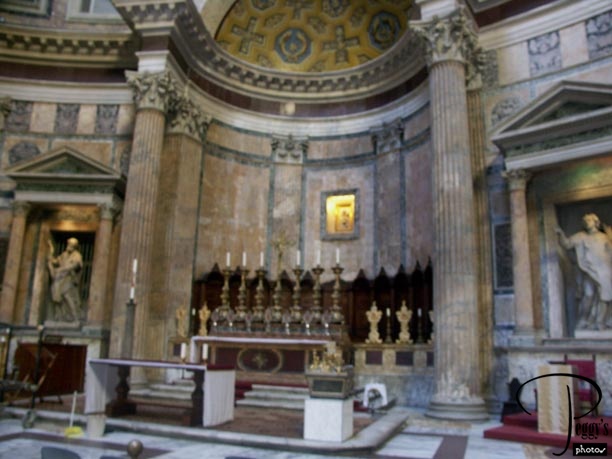
Another view of the inside of the Pantheon.

Inside the Pantheon
Pantheon
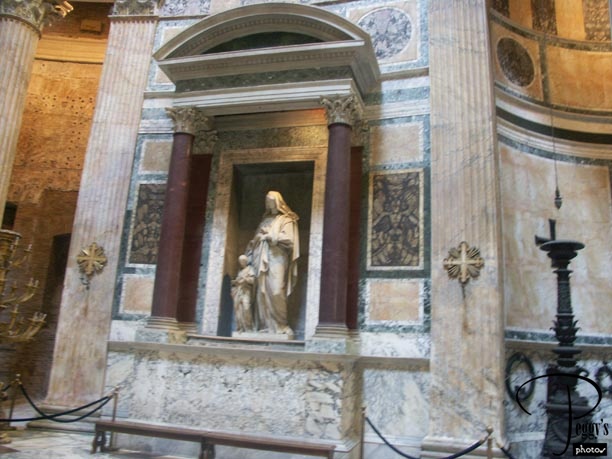
Another view of inside the Pantheon.

Pantheon
Pantheon
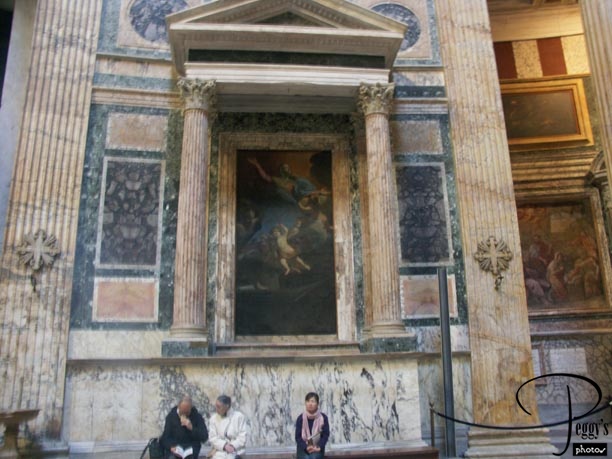
Still another view.

Pantheon
Pantheon
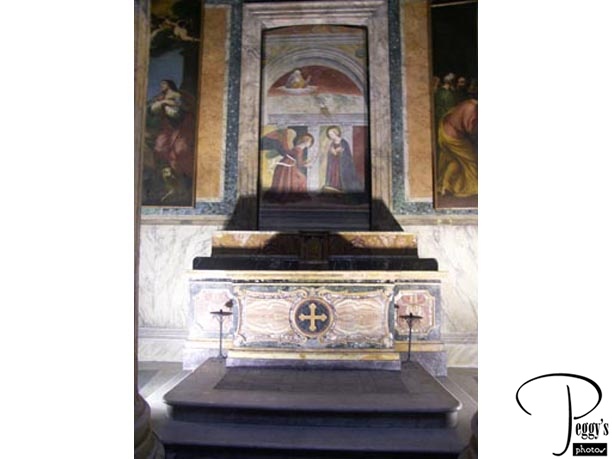
Still another view.

Pantheon
Pantheon
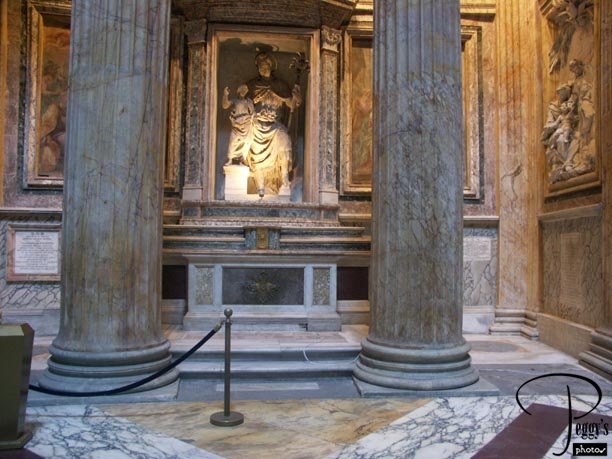
One more view of the inside of the Pantheon.

Pantheon
Piazza Through the Pantheon Columns
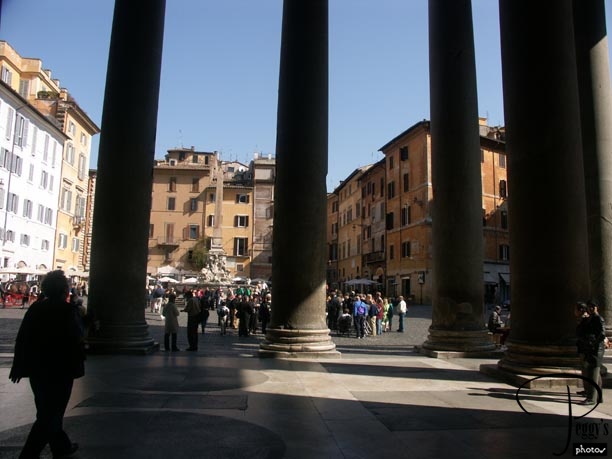
View of the piazza that the Pantheon faces through the columns in front of the Pantheon.

Piazza Through the Pantheon Columns
Piazza della Rotonda

This piazza is the Piazza della Rotonda. Anyway, it is quite lovely.

Piazza della Rotonda
Piazza della Rotonda
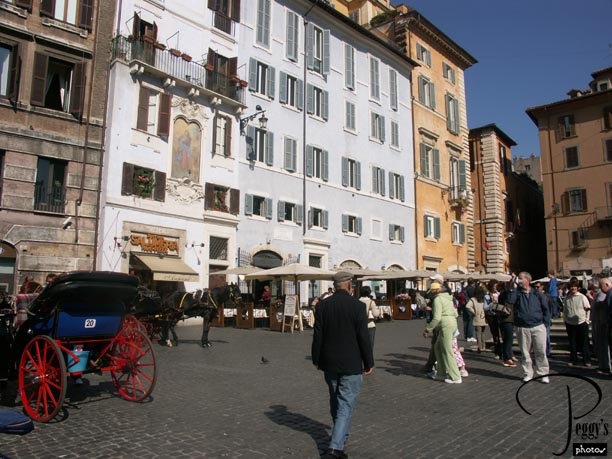
The other side of the piazza.

Piazza della Rotonda
Piazza della Rotonda

Carriage rides are available here. Note the Bancomat in the photo. This is an ATM machine. You find Bancomats along the street, not necessarily in front of bank buildings. You ask for some specific amount of Euros and you get back Euros of different demoninations.

Piazza della Rotonda
Piazza Navona
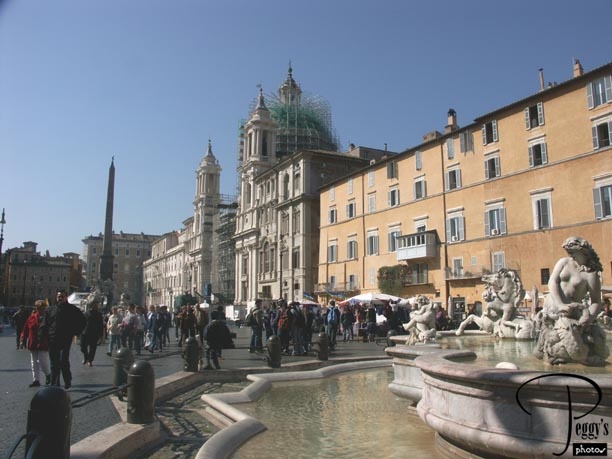
Many people think that this is Rome’s prettiest piazza. I walked through it on my first night in Rome and was glad to be able to see it in the daylight. This piazza is not shaped like a square but as an oblong. There was a Roman racetrack here originally and the piazza has kept this shape. This piazza has been a center of Roman life since ancient times. The church that is being renovated is the Sant’ Agnese in Agone with its facade being by Bernini (one of the artists who transformed Rome into the Baroque style).

Piazza Navona
Piazza Navona
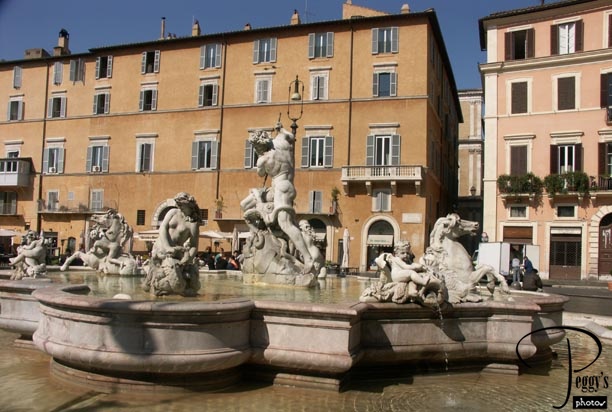
One of the fountains in the Piazza Navona. This is the Fontana del Moro and it was remolded by Bernini in 1653.

Piazza Navona
Piazza Navona
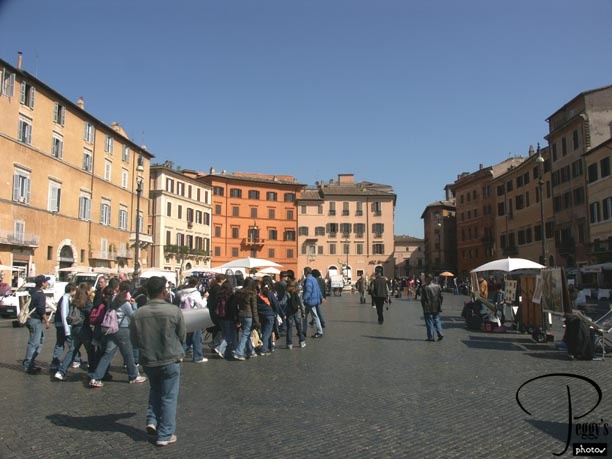
Vendors at the Piazza Navona.

Piazza Navona
Piazza Navona
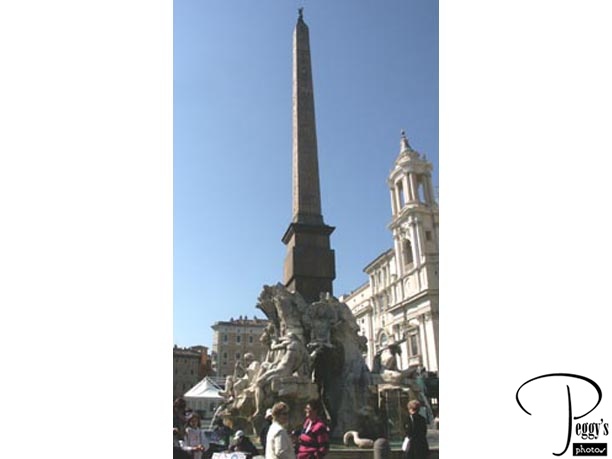
The center fountain at the Piazza Navona. It is the Fontana dei Quattro Fiumi (Fountain of Four Rivers) and was designed by Bernini.

Piazza Navona
Piazza Navona
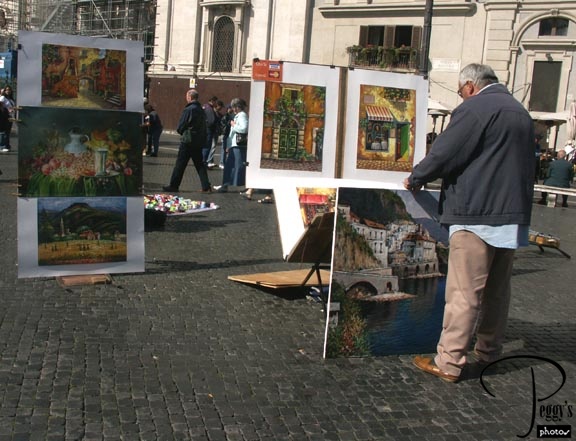
Paintings for sale at the Piazza Navona. We walked from here to get back on our bus (another place in Rome where buses can stop to pick up passengers). We were on our way to St. Peter’s Basilica.

Piazza Navona
St. Peter’s Square
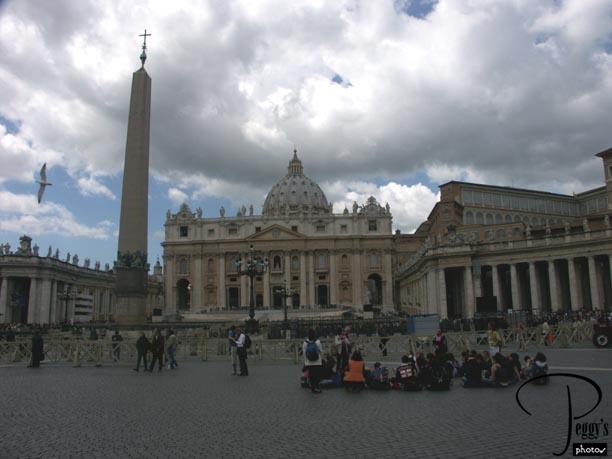
Vatican City has been a separate country since 1929 and it is ruled by the pope. About 1000 people live in Vatican City. Although surrounded by Rome, it has its own laws. The main structures in Vatican City are the Vatican Museum, the Vatican Apartments, the Sistine Chapel, St. Peter’s Basilica, and St. Peter’s Square. This photo shows the focal point of the square, which is St. Peter’s Basilica.

St. Peter’s Square
St. Peter’s Square
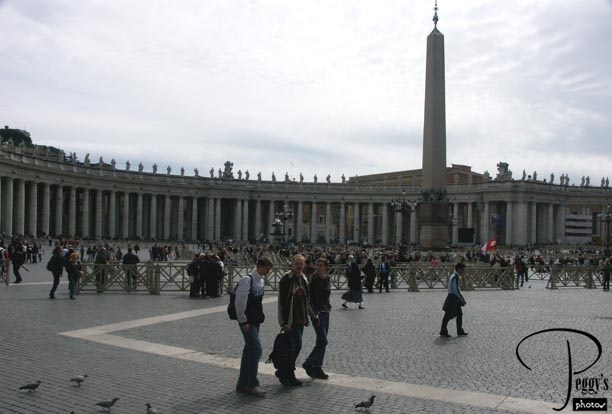
Going to the left of St. Peter’s Basilica. The obelisk was erected in 1586. It is over 2000 years old. The ring of columns around the square represent the arms of the church welcoming all who come here. There are 284 columns and on top of them are 140 statues of saints, chosen by Bernini who designed the square. The square is not really a square but is 660 by 500 feet.

St. Peter’s Square
The Back of the Square

This was the prize media spot. You can also see the taxi stand here––the white cars.

The Back of the Square
To the Right of St. Peter’s Basilica
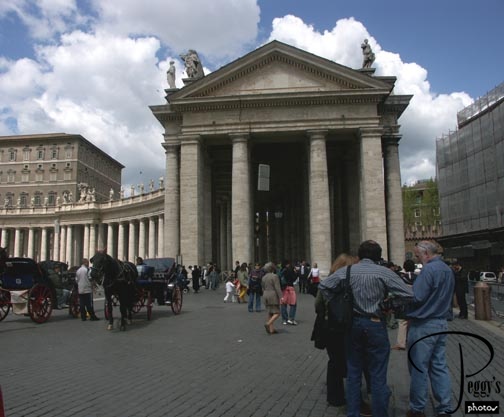
The right side of the colonnade also showing the temple–like entrance to it.

To the Right of St. Peter’s Basilica
Less to the Right of St. Peter’s Basilica
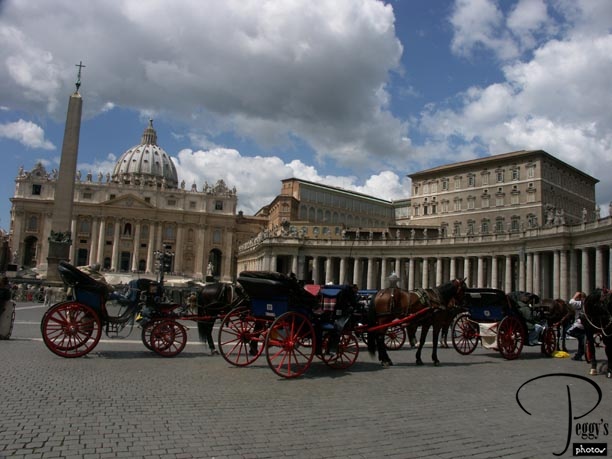
This photo shows the Vatican Apartments behind the colonnade.

Less to the Right of St. Peter’s Basilica
St. Peter’s Square
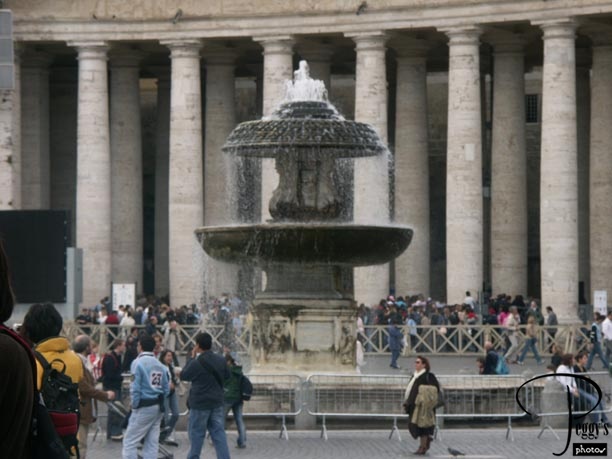
One of the fountains on St. Peter’s Square.

St. Peter’s Square
Statues
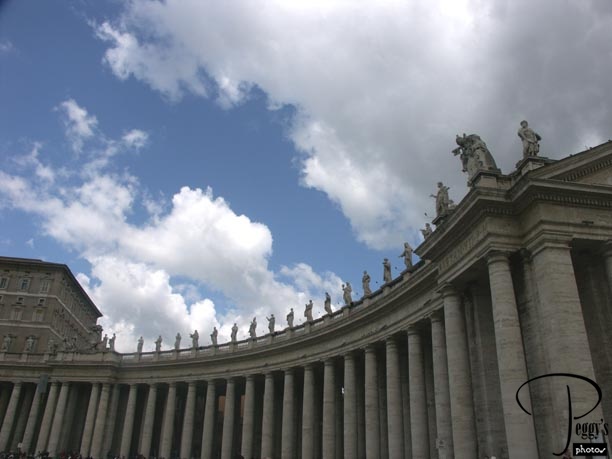
The statues of the saints on top of the columns.

Statues
Statues
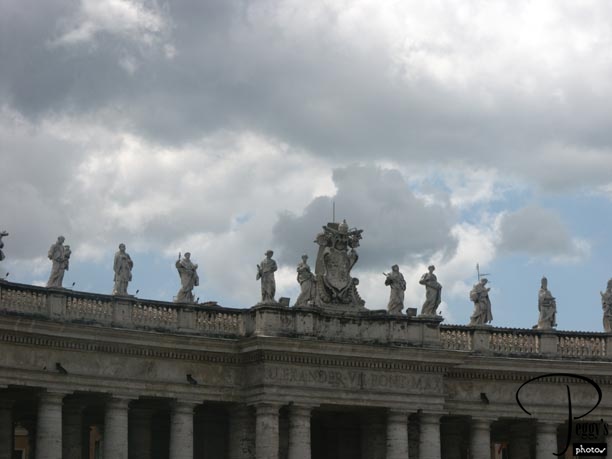
Closer–up view of the statues of the saints.

Statues
Statues
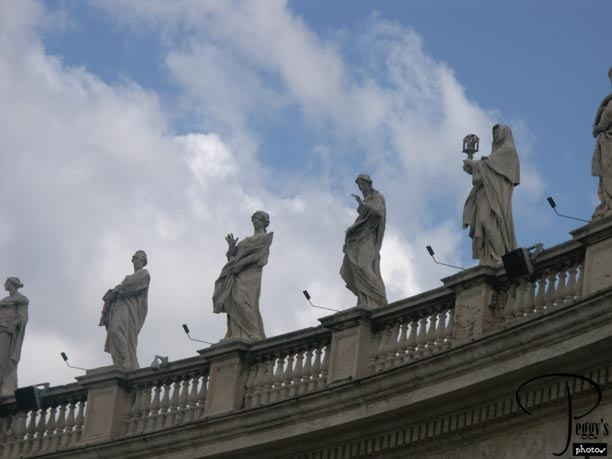
Another view of the statues.

Statues
Vatican Clock
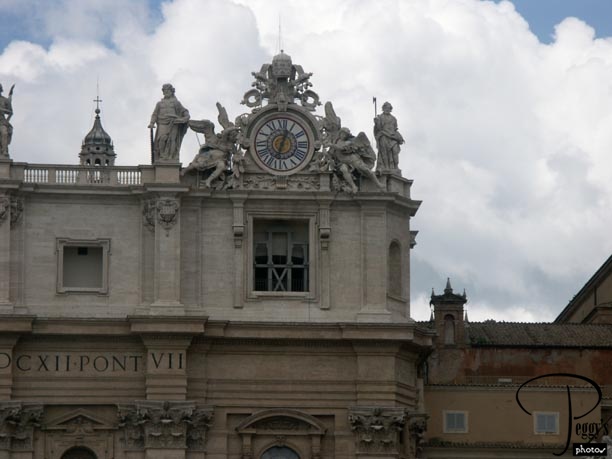
Clock in St. Peter’s Square

Vatican Clock
Balcony at Front of St. Peter’s Basilica
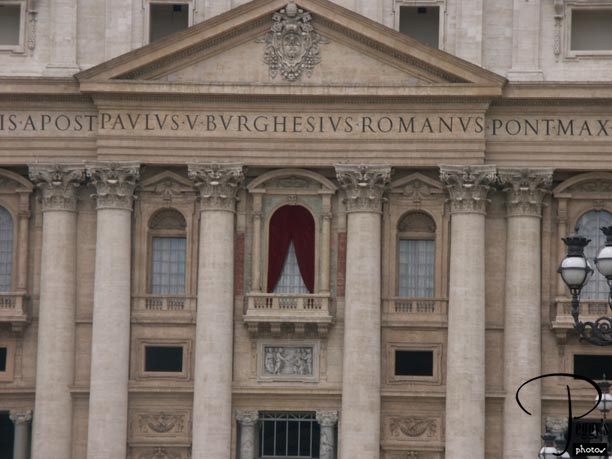
This balcony is used by the pope for formal occasions. The pope usually gives his Wednesday and Sunday blessings from his apartment. Some of my later tour members went to St. Peter’s Square on May 8 for the Mother’s Day Blessing. They couldn’t see the pope clearly but there were video screens in the square on which they could see him. They said that various parts of the crowd cheered when Pope Benedict XVI gave the blessing in their native language.

Balcony at Front of St. Peter’s Basilica
St. Peter’s Basilica
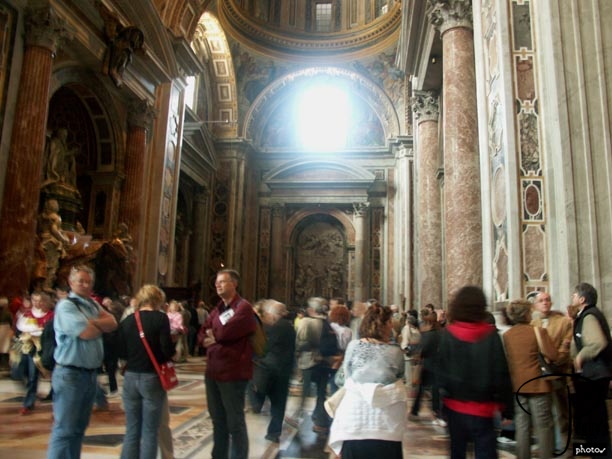
Our group got at the end of a very long line to visit St. Peter’s Basilica. However, the line moved quickly. We had to go through a security check before we could enter the basilica. This photo shows us entering the basilica. St. Peter’s Basilica is huge––two football fields long. It has 11 chapels and 45 altars. A mass was being given at one of the altars when we were there and we could see the preparations for another mass to be held at another altar as soon as the first mass was finished. Here you can also visit the Grottoes, the Treasury, and St. Peter’s Sacristy and also climb up to the terrace for some great views. I didn’t do any of the latter as I didn’t have time. There was quite a long line to see the tomb of Pope John Paul II, but some members of my later tour group said they went to the basilica at 8 a.m. one morning and got right in.

St. Peter’s Basilica
St. Peter’s Basilica
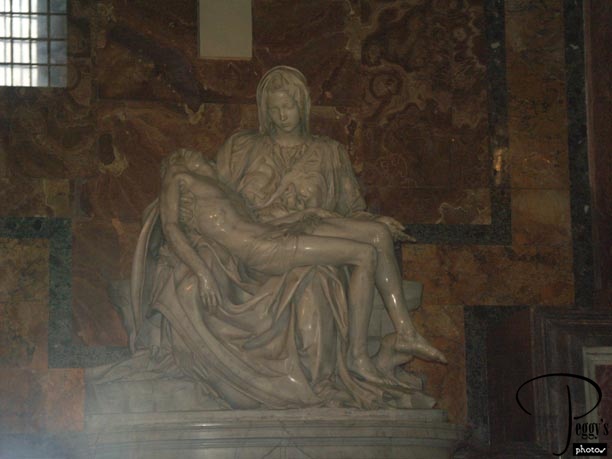
I have put the photos that I took inside St. Peter’s Basilica on a slide show on this site: Go to Slide Shows, Western Europe, Italy–1, “Rome, St. Peter’s Basilica.” There are two photos on it that I don’t want you to miss, so I am putting another photo of Michelangelo’s Pieta, which is in the basilica, here so you will recognize it in the slide show. After leaving St. Peter’s, I took a taxi to the Palatine Hill, which is near the Colosseum.

St. Peter’s Basilica
Palatine Hill
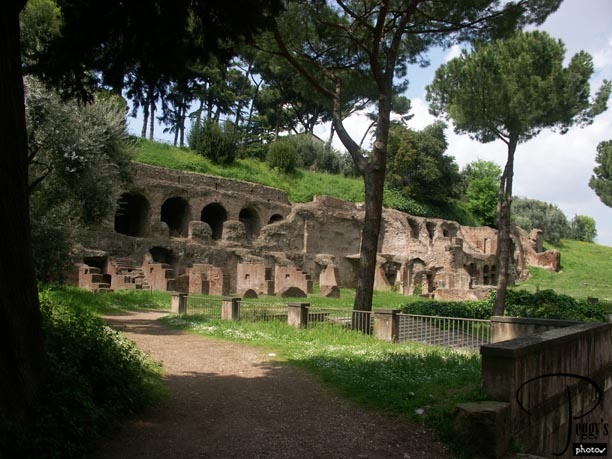
According the famous legend, Romulus and Remus were reared by a wolf in a cave on Palatine Hill. The hill was also the site of a Roman imperial palace that was the residence of Roman emperors for three centuries. It also included dwellings of some famous Romans. Today, most of it is in ruins, but it is a great place to visit as not too many tourists make it up the hill from the Forum or from near the Colosseum, so it is very quiet here. Photo: The entrance to Palatine Hill coming from the Colosseum.

Palatine Hill
Roman Aqueduct
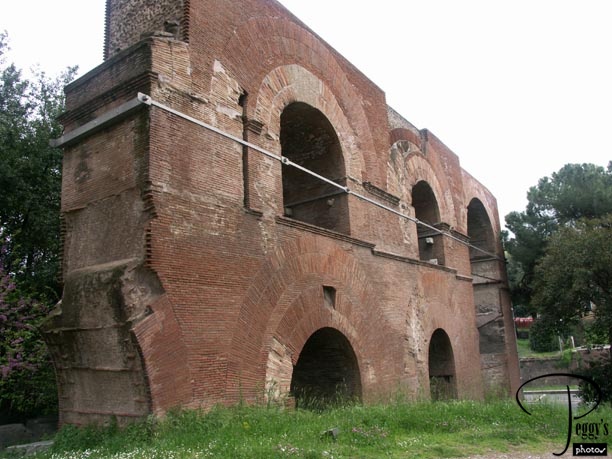
Remains of a Roman aqueduct seen on the way up to Palatine Hill.

Roman Aqueduct
Palace of Septimius Severus
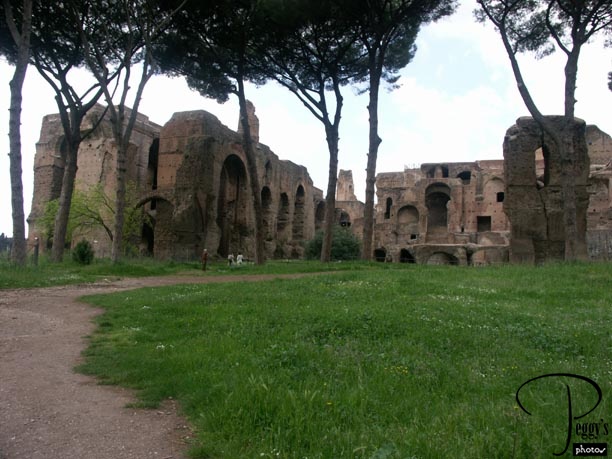
Septimius Severus reigned between 193 and 211 A.D. (I have tried to identify correctly the ruins in the photos that I have put in this album, but sometimes it was hard to be absolutely sure what the ruin was.)

Palace of Septimius Severus
Close-up of the Palace
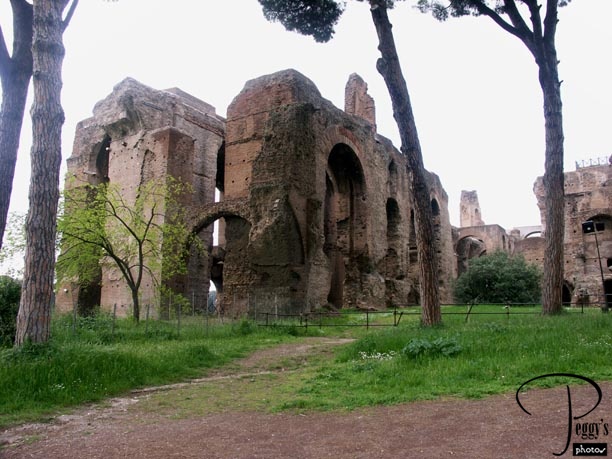
Close–up of the Palace of Septimius Severus.

Close-up of the Palace
Entrance to the Palace
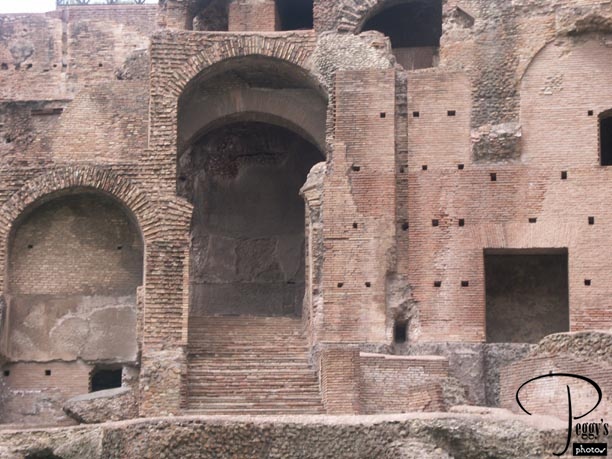
One of the entrances to the Palace of Septimus Severus.

Entrance to the Palace
The Stadium
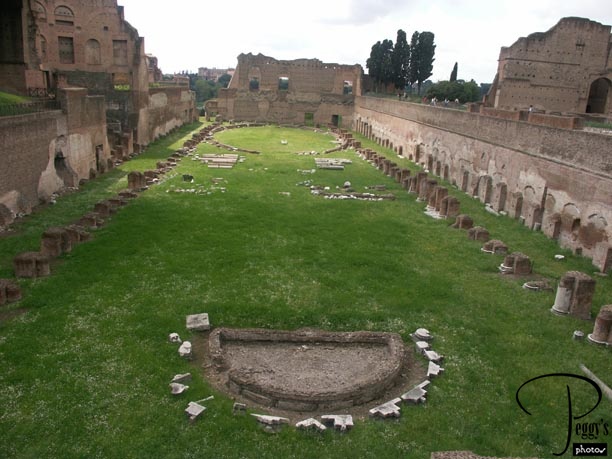
This stadium was part of the imperial palace.

The Stadium
The Stadium
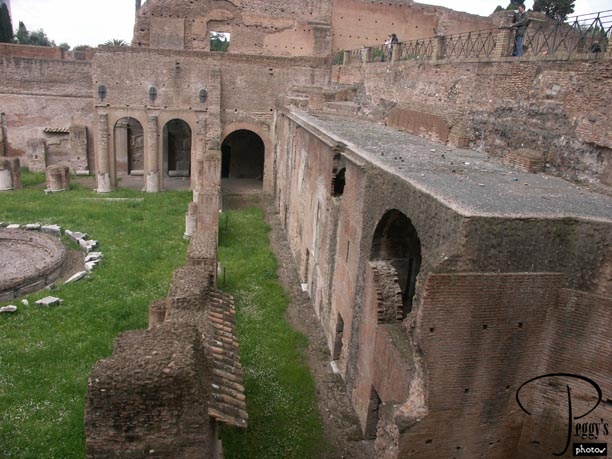
Close–up of the stadium.

The Stadium
House of Domus Augustana
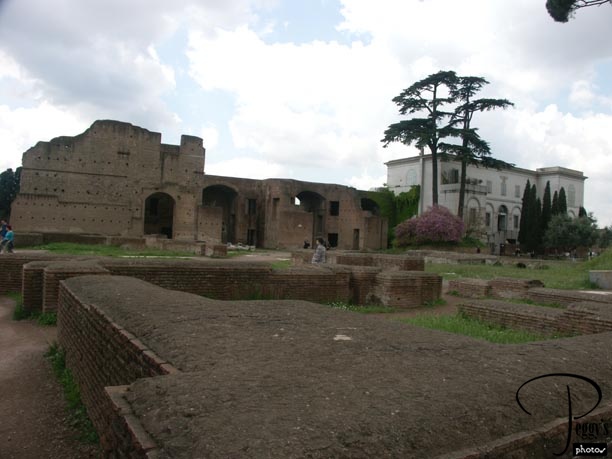
The house of Domus Augustana is on the left in the photo. It was the private part of the palace and contained the rooms of the emperor and his family. The Roman emperors lived in this part of the palace. The building on the right is the Palatine Museum which used to be a convent.

House of Domus Augustana
Lower Courtyard
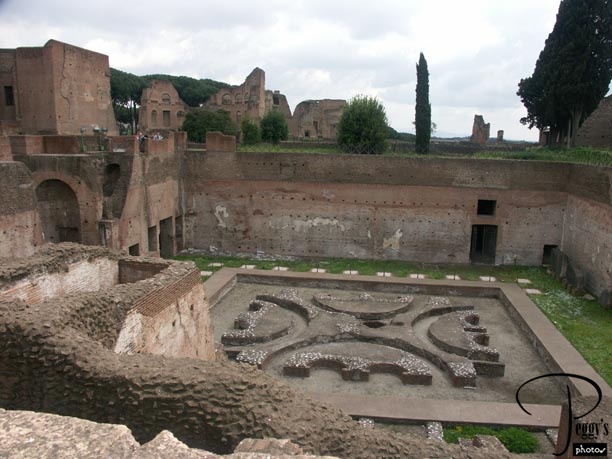
The lower courtyard of the palace.

Lower Courtyard
Banquet Hall
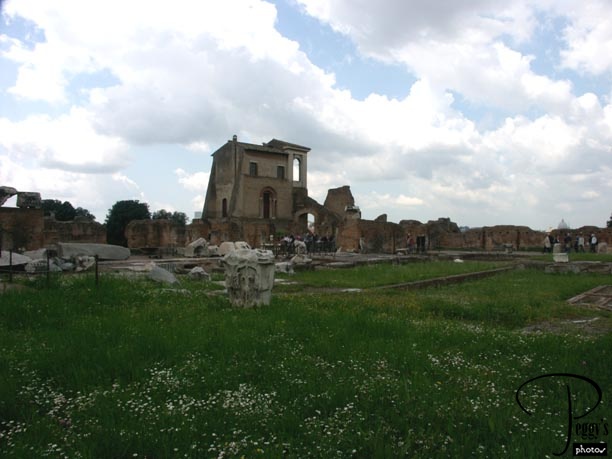
The banquet hall of the palace.

Banquet Hall
Another View of the Banquet Hall
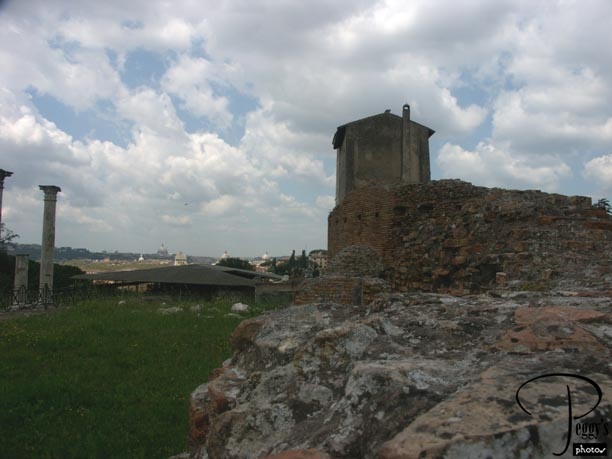
You can see the dome of St. Peter’s Basilica in this photo.

Another View of the Banquet Hall
Circus Maximus
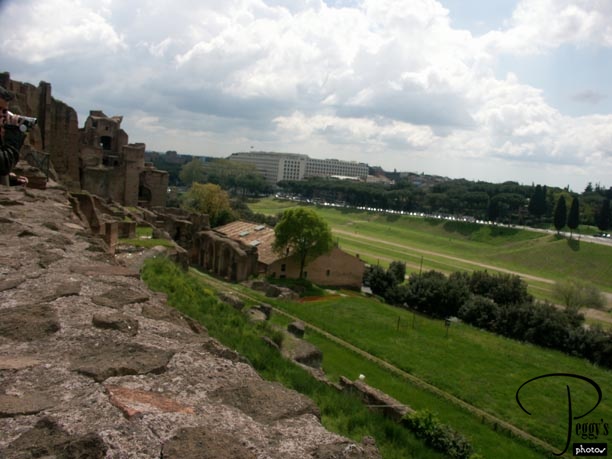
The Circus Maximus seen from Palatine Hill. This was Ancient Rome’s largest stadium and was where the chariot races were held. Today, it is just a large oblong grassy field where present–day Romans take walks.

Circus Maximus
Temple of Cybele
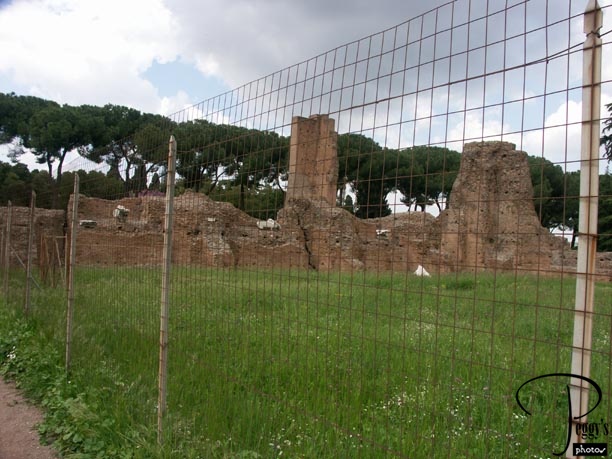
This is also called the Temple of Magna Mater and was the center of an important fertility cult.

Temple of Cybele
House of Livia and Augusta

Augusta was the first Roman emperor.

House of Livia and Augusta
The Throne Room
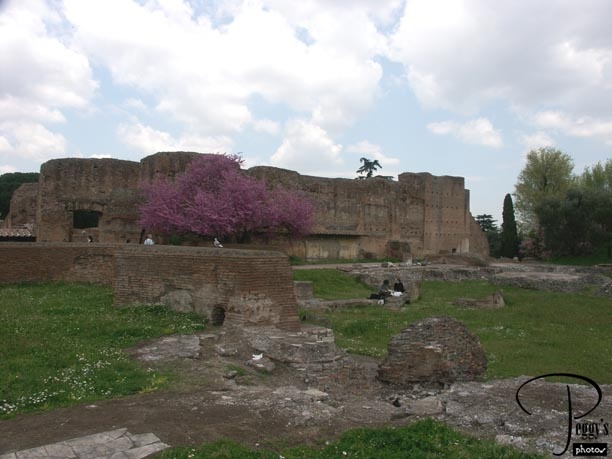
The Throne Room of the palace.

The Throne Room
The Throne Room
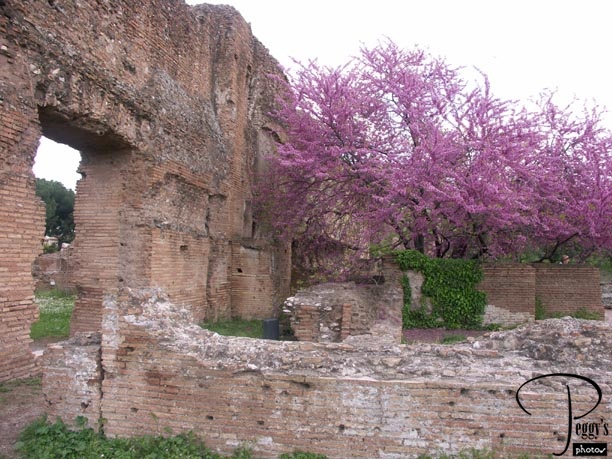
Another view of the Throne Room.

The Throne Room
The Palace Complex
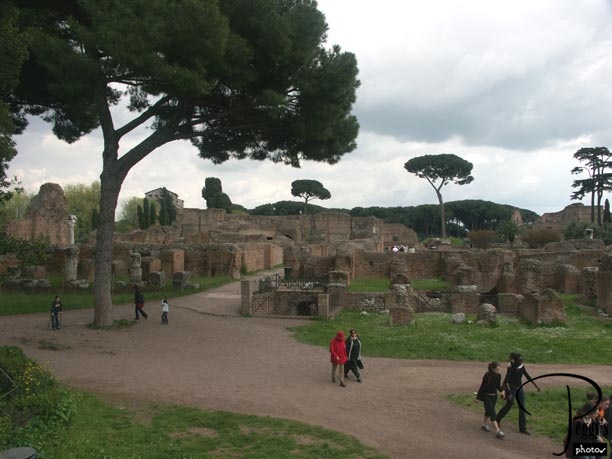
View of other ruins of the palace complex.

The Palace Complex
Cryptoporticus Tunnel
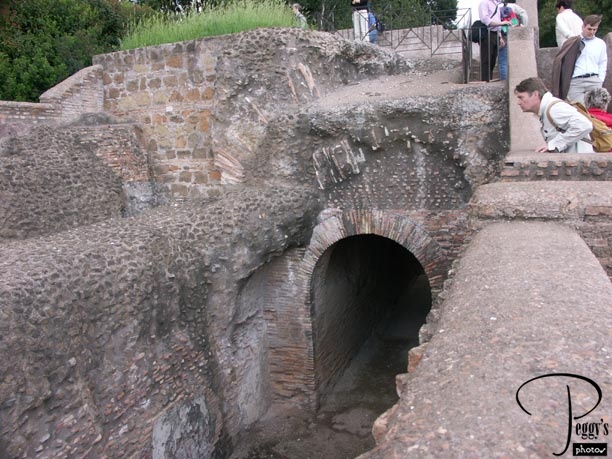
This tunnel connected the palace to the Forum and was 460 feet long.

Cryptoporticus Tunnel
Huts of Romulus and Remus
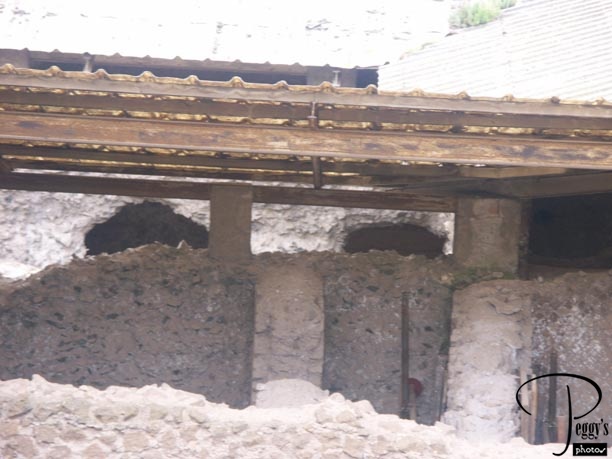
These huts (opening behind the walls) date back to 850 B.C. Romulus and Remus were orphaned when their mother, a Vestal Virgin who broke her vows, was executed. They were thrown into the Tiber River but were rescued by a She Wolf who raised them. When grown, Romulus killed his brother so he could have supreme power and founded the city of Rome. Of course, this is a legend, but these huts were found in 1940 and are considered to be the huts where Romulus and Remus were raised (or, more believable, that they were remains of Iron Age huts which were the first dwellings of ancient Rome).

Huts of Romulus and Remus
Entrance to Palatine Hill
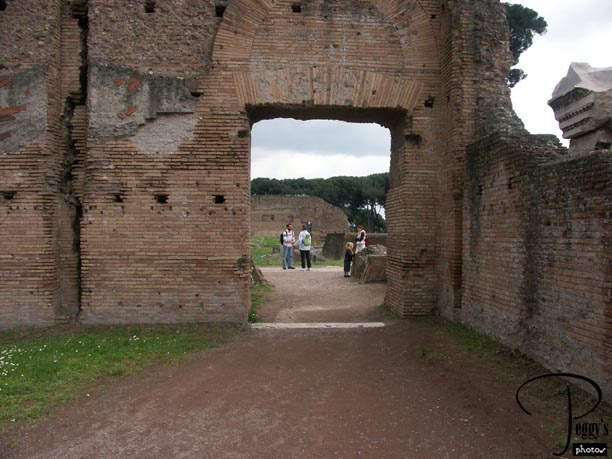
The original entrance to Palatine Hill. I went through the entrance on my way down the hill rather than on my way up the hill because of the way I approached the ruins.

Entrance to Palatine Hill
View of the Colosseum
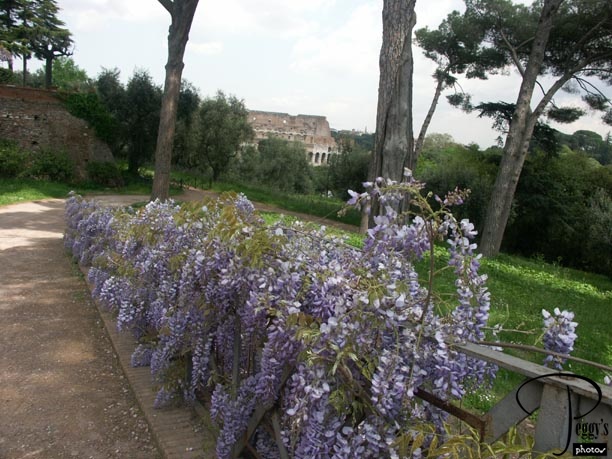
You can see a bit of the Colosseum on your way down the hill. I enjoyed my visit to Palatine Hill, especially the respite from the noise of Rome. I was going to head next for the St. Peter’s in Chains church, but after looking for directions to it in my book, I discovered that it was closed for an afternoon break. I was to meet my Trafalgar tour group at my hotel at 4 p.m., so I decided that I would just hop on the Metro at the Colosseum and go back to my hotel. When I got to the Metro, its entrance was blocked––it was on strike! So I got on a bus that would take me to Piazza Venezia where I had seen, on my second night in Rome, some buses that would go to Piazza Bolgona. But at Piazza Venezia, I couldn’t find any buses on the route boards going there. I found a bus information booth there and asked where I could catch the bus. I got another “over there” wave. I told the man that I had already been “over there” and didn’t see a stop. He again gave me the “over there” wave, but on my way back “over there somewhere” I was able to flag down a taxi and took it back to my hotel. I even had time when I got back to get a piece of pizza (shrimp, lettuce, and tomato sauce again) and some cookies at the pastry shop (my lunch). Well, this concluded my Doing Rome by Myself adventure. I think that I did just fine. No one bothered me. I don’t think anyone even noticed me––I was just another of the many thousands of tourists who had descended on Rome when I was also there. But I wished that I had had more confidence in myself before my trip and had stayed longer in Rome––there is just too much to see in this city to see all you will want to see in just a few days.
